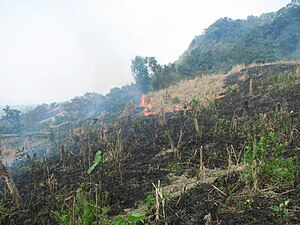
Slash-and-burn
Slash-and-burn agriculture is a farming method that involves the cutting and burning of plants in a forest or woodland to create a field called a swidden. The method begins by cutting down the trees and woody plants in an area. The downed vegetation, or "slash", is then left to dry, usually right before the rainiest part of the year. Then, the biomass is burned, resulting in a nutrient-rich layer of ash which makes the soil fertile, as well as temporarily eliminating weed and pest species. After about three to five years, the plot's productivity decreases due to depletion of nutrients along with weed and pest invasion, causing the farmers to abandon the field and move to a new area. The time it takes for a swidden to recover depends on the location and can be as little as five years to more than twenty years, after which the plot can be slashed and burned again, repeating the cycle.[1][2] In Bangladesh and India, the practice is known as jhum or jhoom.[3][4][5]
For the military strategy, see Scorched earth.
Slash-and-burn is a type of shifting cultivation, an agricultural system in which farmers routinely move from one cultivable area to another. A rough estimate is that 250 million people worldwide use slash-and-burn.[6] Slash-and-burn causes temporary deforestation. Ashes from the burnt trees help farmers by providing nutrients for the soil.[7] In low density of human population this approach is very sustainable but the technique is not scalable for large human populations.[8]
A similar term is assarting, which is the clearing of forests, usually (but not always) for the purpose of agriculture. Assarting does not include burning.[9]
History[edit]
Historically, slash-and-burn cultivation has been practiced throughout much of the world. Fire was already used by hunter-gatherers before the invention of agriculture, and still is in present times. Clearings created by the fire were made for many reasons, such as to provide new growth for game animals and to promote certain kinds of edible plants.
During the Neolithic Revolution, groups of hunter-gatherers domesticated various plants and animals, permitting them to settle down and practice agriculture, which provided more nutrition per hectare than hunting and gathering. Some groups could easily plant their crops in open fields along river valleys, but others had forests covering their land. Thus, since Neolithic times, slash-and-burn agriculture has been widely used to clear land to make it suitable for crops and livestock.[10]
Large groups wandering in the woodlands was once a common form of society in European prehistory. The extended family burned and cultivated their swidden plots, sowed one or more crops, and then proceeded on to the next plot.[11]
Research[edit]
This type of agriculture is discouraged by many developmental or environmentalist organisations, with the main alternatives being promoted are switching to more intensive, permanent farming methods, or promoting a shift from farming to working in different, higher-paying industries altogether. Other organisations promote helping farmers achieve higher productivity by introducing new techniques.
Not allowing the slashed vegetation to burn completely and ploughing the resultant charcoal into the soil (slash-and-char) has been proposed as way to boost yields.[21]
Promoters of a project from the early 2000s claimed that slash-and-burn cultivation could be reduced if farmers grew black pepper crops between Inga trees, which they termed 'Inga alley cropping'.[22]
A method of improving the yields in a type of traditional assarting cultivation used to grow common beans in Central American called 'slash-and-cover', has been proposed, by additionally planting leguminous shrubs to act as a fallow crop after the soil is exhausted and one is ready to clear a new patch of forest.[23]

